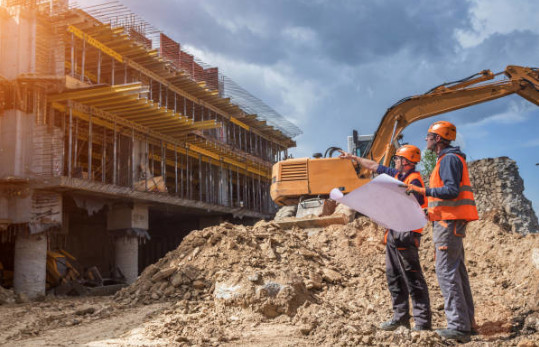Leading Consulting Civil Engineering Companies for Facilities Projects
Leading Consulting Civil Engineering Companies for Facilities Projects
Blog Article
Exactly How Consulting Engineers Enhance Geotechnical Design Projects: Insights Into Their Experience, Methodologies, and Collaborative Approaches
Consulting designers are essential in improving geotechnical design tasks, applying their specialized understanding to browse the intricacies of subsurface problems. Their approaches encompass a variety of website examination techniques, consisting of Criterion Penetration Examinations (SPT) and Cone Infiltration Tests (CPT), which inform essential choices during the layout and building and construction phases. Their collaborative techniques foster communication among diverse task stakeholders, eventually forming the job's trajectory. As we take a look at the diverse roles these professionals play, it comes to be clear that their payments expand past technological knowledge, triggering a better take a look at the implications for project success.
Function of Consulting Engineers
The proficiency of getting in touch with designers in geotechnical design is essential to the effective implementation of building and construction projects. These specialists play an essential role in examining dirt and rock buildings, which are crucial factors affecting layout and building and construction decisions. By conducting thorough site investigations, seeking advice from designers collect essential data that educates the layout procedure, ensuring projects are developed on secure and suitable ground.
Consulting designers additionally give important insights right into danger monitoring (geotechnical geologist). They determine potential geotechnical hazards, such as landslides, soil liquefaction, and negotiation issues, making it possible for stakeholders to carry out effective reduction approaches. Their knowledge aids in maximizing structure layouts, which can bring about significant price financial savings and enhanced security
Moreover, consulting engineers offer as an important link between project proprietors, architects, and specialists. Their capacity to translate intricate geotechnical information right into actionable referrals promotes cooperation and facilitates informed decision-making throughout the job lifecycle. This multidisciplinary strategy not only boosts job effectiveness but likewise makes sure conformity with governing criteria and best techniques.
Trick Methods in Geotechnical Design

One main method is site examination, which entails conducting field tests and lab evaluations to gather information on subsurface conditions. Methods such as Standard Infiltration Testing (SPT) and Cone Penetration Screening (CPT) are extensively made use of to review soil stratigraphy and stamina. In addition, geophysical techniques, including seismic and electrical resistivity surveys, offer non-invasive methods to examine subsurface features.
An additional crucial technique is numerical modeling, which enables designers to replicate various situations and forecast how soil-structure interactions will behave under various loading problems. Limited Element Analysis (FEA) is an usual approach used in this context.
Furthermore, the design of structures, maintaining structures, and earthworks relies heavily on these methodologies - geotechnical click this link geologist. By integrating advanced logical tools with field information, speaking with designers can create tailored remedies that resolve particular task challenges, ultimately adding to the security and safety and security of building jobs
Importance of Soil Evaluation
Dirt evaluation functions as a foundational element in geotechnical engineering, providing important understandings into the physical and chemical homes of dirt required for effective building planning. Recognizing dirt characteristics is critical for determining its load-bearing capacity, drainage behavior, and potential for settlement or instability. In-depth soil examinations, consisting of sampling and lab testing, help recognize specifications such as dirt kind, wetness material, thickness, and shear stamina.
These evaluations educate the selection of appropriate building and construction strategies and materials, eventually influencing task security and durability. Natural dirts might require various structure designs compared to granular dirts, requiring tailored design services. Additionally, dirt analysis help in recognizing impurities that might present dangers to human health and wellness or the environment, enabling the advancement of mitigation approaches.
Integrating dirt evaluation right into the onset of task growth helps to lessen unforeseen challenges, making certain that engineers can prepare for and deal with potential issues before they escalate. By establishing a comprehensive understanding of the website problems, getting in touch with engineers can optimize style efficiency and lower expenses, thus enhancing the overall success of geotechnical design jobs.
Collaborative Strategies in Jobs
Effective geotechnical jobs typically rest on joint techniques that unite go to these guys diverse knowledge from different self-controls. Effective partnership amongst speaking with engineers, geologists, environmental researchers, and construction professionals is important for resolving complex obstacles and optimizing project outcomes. By leveraging the special skills and understanding of each group member, tasks can gain from a holistic understanding of the site problems, governing needs, and engineering constraints.
Routine interaction and interdisciplinary meetings help with the sharing of insights and promote a society of teamwork. These collective initiatives allow the recognition of potential threats early in the task lifecycle, enabling timely mitigation methods. Furthermore, integrating responses from stakeholders, consisting of regional neighborhoods and regulative agencies, guarantees that all perspectives are taken into consideration, enhancing task acceptance and compliance.
Additionally, the combination of innovative technologies, such as Geographic Info Systems (GIS) and Structure Information Modeling (BIM), further improves partnership. These devices enable the real-time sharing of information and visualization of geotechnical conditions, promoting notified decision-making. Ultimately, a collaborative strategy not only streamlines project execution however likewise lays the structure for ingenious services to intricate geotechnical engineering difficulties.
Impact on Project Outcomes

Consulting designers use advanced methodologies such as danger analysis and anticipating modeling, which improve the precision of job projections. Their capability to incorporate innovative innovations, like geotechnical instrumentation and information analytics, better improves the design and building and construction procedures. Therefore, jobs experience improved efficiency, lowered costs, and lessened delays.
Furthermore, cultivating effective communication and collaboration among staff member improves problem-solving capacities. When obstacles occur, a joined front allows for speedy identification of services, avoiding possible obstacles. Eventually, the joint efforts of seeking advice from designers add to better end results, ensuring that jobs fulfill both governing standards and client assumptions.
Verdict

Report this page